Prior Developments

A number of prior developments would prove influential on the development of video games. For a detailed history of computers, without which video games as we know them would not exist, please read the Wikibook History of Computers.
People have desired autonomous entertainment since ancient times. This is evidenced by the Ancient Greeks, who are said to have built a theater of automatons in Alexandria.[2] Early concepts of simulated realities can also be seen in Plato's Allegory of the Cave.[3] In particular, Hero of Alexandria describes automated theater systems in Automatopoietica, including moving not only automaton actors in 3D space, but also tricks that would later be used by 3D games, such as using 2D graphics convincingly in a 3D space.[4]
The Mechanical Turk of the 1770s showed a desire by people to play games with a machine,[5] though in truth the machine was operated like a puppet by a human hidden beneath the playtable.
During the 1880's the war of the currents highly influenced electric standards.[6][7][8] The resulting AC standards would influence television standard refresh rates,[9] and in turn influence standard video game refresh rates.[10]
Depending on the source, Joysticks were either invented during the American Civil War between 1861 and 1865 for use in submarines at the earliest,[11] or invented in 1923 by C. B. Mirick while working for the US Naval Research Laboratory at the latest.[12][13]
Earliest electronic games
Cathode Ray Tube Amusement Device
The earliest known computer gaming system is the cathode-ray tube amusement device, a device which enabled its user to use its CRT system to project an electron beam on targets positioned on the screen. The game was designed by Thomas T. Goldsmith, Jr. and Estle Ray Mann, who patented it in 1947, although it was never built or sold.[14]
Early strategy games
A later analog computer game, Bertie the Brain, was released by Josef Kates on August 25, 1950. Bertie the Brain was a tic-tac-toe simulator, in which the user played against the computer a tic-tac-toe game, while John Makepeace Bennett and Raymond Stuart-Williams's Nimrod computer, manufactured by Ferranti and based on Edward Condon's "Nimatron" machine, was a huge analog computer released on May 5, 1951 designed to play Nim against the user. Instead, in the same year, Dietrich Prinz wrote the first computer chess simulator on a Ferranti Mark I machine, followed by Christopher Strachy's 1952 draughts simulator for the same computer. This games were mainly experiments to demonstrate the potential power of computing machines and to develop AI, more than entertainment software.
 The cathode ray tube amusement device's schematics from its patent.
The cathode ray tube amusement device's schematics from its patent.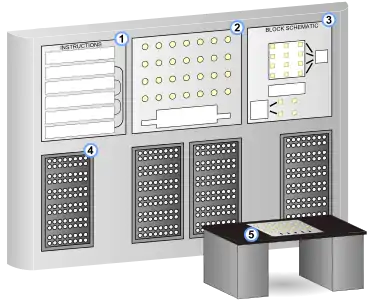 A rendering of the Nimrod.
A rendering of the Nimrod.
First interactive games
Meanwhile, A S Douglas developed and realized the tic-tac-toe software OXO (or "Naughts and Crosses"), it was a computer-versus-user game based on screen vision running on the electronic delay storage automatic calculator (EDSAC, a stored-program computer housed in the University of Cambridge's Mathematical Laboratory), in other words, the user (after receiving a special authorization to use the EDSAC) could, for one of the first times, see the game on the computer's screen. Six years later, in 1958, the first known entertainment computer game, the tennis simulator Tennis for Two, or "Computer Tennis" (designed by Los Alamos nuclear scientist William Higinbotham and built by Robert Dvorak at the Brookhaven National Laboratory, where it was shown every year). Tennis for Two, which could be played by two players using two early controllers (each with a button to hit the ball and a knob to change the angle of the trajectory), ran on an analog computer with an oscilloscope as screen and had the following gameplay: a horizontal line represented the tennis court as seen by its side, a vertical dash in the center represented the net and, once the first player started the game, the ball (a dot of light) could be used to play. The ball could hit the net, land inside or outside the yard and, when it was on one's side, he or she could use the button to virtually hit it again, but the game did not have any points nor an "end": users simply had to play.
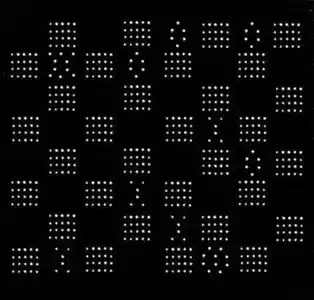 Strachy's draughts software, one of the first screen-based visual games.
Strachy's draughts software, one of the first screen-based visual games..jpg.webp) The EDSAC, the computer which ran OXO, which shares the draughts simulator's record.
The EDSAC, the computer which ran OXO, which shares the draughts simulator's record.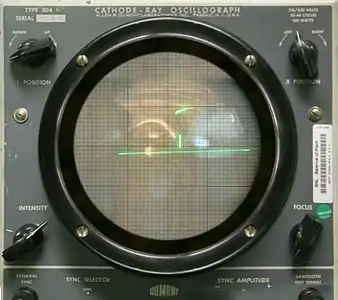 A Tennis for Two game on a DuMont Lab Type 304-A oscilloscope. Tennis for Two is mainly considered History's first video game.[15]
A Tennis for Two game on a DuMont Lab Type 304-A oscilloscope. Tennis for Two is mainly considered History's first video game.[15] A modern replica of one of Tennis for Two's two controllers.
A modern replica of one of Tennis for Two's two controllers.
Spacewar! and mainframe games
In the first years of the 1950s most mainframe computers were unsuitable for gaming, being relatively weak in memory and speed, but, in the early decade, an MIT Lincoln Laboratory research team, with Jay Forrester as head, developed, to the US Navy's gain, the perfectioned and more powerful Whirlwind I. Inspired by their work, researchers Ken Olsen and Wes Clark built the prototype machine TX-0 (Transistorized Experimental computer zero, nicknamed "tixo"), based on early transistor technology.
Clark and Harlan Anderson soon founded the Digital Equipment Corporation, or "DEC", and tixo was updated to be publicly sold under the new name "PDP-1" (Programmed Data Processor-1, one of the most notable computers in the hacker culture). In 1962, on the MIT's own PDP-1, used by later MIT students and professors, Steve Russell created Spacewar!, the first widespread video game. Spacewar! was another two-players game, in which's two-dimensional world each user controlled a spacecraft with a rear thruster (with limited fuel), yaw variation capabilities and a frontal weapon, orbiting a gravity source against a starfield background; the craft were destroyed (but soon regenerated) if the were shot by the other's weapon or they collided (with the other's ship or with the gravity source), generating explosion effects, but could also use the gravity to their advantage, jump into hyperspace to reappear at a random point of the battlefield (but increasing the probability to explode during re-entry) and use the warp screen effect ("exiting" the screen to reappear on the opposite side) to travel between two opposite points of the screen in brief time (thus avoiding the gravity source).
Other notable mainframe games (mainly written in various FOCAL dialects) include Witold Podgórski's 1962 Marienbad (an Odra 1003 Nim computer game inspired to the film Last Year at Marienbad), Doug Dyment's 1968 text-based game Hamurabi (a PDP-8 game, rewritten in BASIC in the 1973 book BASIC Computer Games, in which the player impersonated Babylonian king Hammurabi and had to participate in ancient politics) and Ken Thompson's 1969 Space Travel (a multi-platform non-combat spaceflight simulator).
 The TX-0 computer, which revolutionized the mainframe computer industry.
The TX-0 computer, which revolutionized the mainframe computer industry. Spacewar! runs on the Computer History Museum's PDP-1.
Spacewar! runs on the Computer History Museum's PDP-1.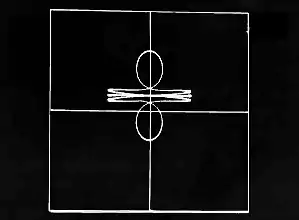 An ongoing session of Space Travel.
An ongoing session of Space Travel.
Early arcade games
In 1971, the first arcade games (usually coin-operated video game-based machines) were presented: they were the Computer Space by Syzygy Engineering ("Syzygy" was the name of the partnership between Nolan Bushnell and Ted Dabney, originally born, inspired by Spacewar!, to found a computer games-equipped restaurant, later destined to become Atari, Inc.), though manufactured by Nutting Associates, and the PDP-11-based coin-operated Spacewar! clone Galaxy Game by Bill Pitts and Hugh Truck (a two-player arcade which enabled to play, though in with lower video and reaction quality, a multi-mode re-creation of the 1962 game, built and, for a long time, kept at Stanford University). Arcades were soon seen as a notable way to earn money easily, and, soon, other famous video game cabinets manufacturers were born: in 1972 Atari itself realized the table tennis simulator Pong by Allan Alcorn, one of the first best-selling games, as well as the inspiration for the first video game consoles; in 1973 Taito published its first game, Astro Race, a racing simulator; in 1976 Sega published Moto-Cross, the first game to provide haptic feedback (tactile output), better known as published under the Happy Days-themed label "Fonz".
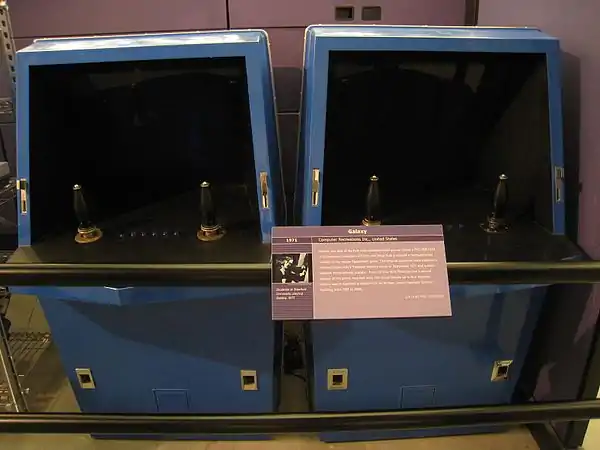 Two Galaxy Game cabinets at the Computer History Museum.
Two Galaxy Game cabinets at the Computer History Museum. Atari's notorious arcade game Pong running.
Atari's notorious arcade game Pong running.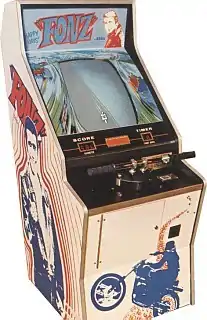 A Fonz-style Moto-Cross cabinet.
A Fonz-style Moto-Cross cabinet.
Read more
- History of Computers - Wikibook on the history of computers, which is a foundational technology for most video games.
References
- ↑ "The Mechanical Turk: How a Chess-playing Hoax Inspired Real Computers" (in en). Discover Magazine. https://www.discovermagazine.com/technology/the-mechanical-turk-how-a-chess-playing-hoax-inspired-real-computers.
- ↑ "Automation in the Ancient World: The Robots of Greece and Rome". 31 January 2020. https://classicalwisdom.com/culture/history/automation-in-the-ancient-world/.
- ↑ "Allegory of the Cave". https://faculty.washington.edu/smcohen/320/cave.htm.
- ↑ Xagoraris, Zafirios (1991). The automaton theater. Massachusetts Institute of Technology. https://dspace.mit.edu/handle/1721.1/70642. Retrieved 16 January 2021.
- ↑ Staff, T. B. S. (20 July 2015). "A Brief History of Computer Chess". TheBestSchools.org. https://thebestschools.org/magazine/brief-history-of-computer-chess/.
- ↑ "The War of the Currents: AC vs. DC Power" (in en). https://www.energy.gov/articles/war-currents-ac-vs-dc-power.
- ↑ "‘War of the Currents’ Had Profound Impact (Published 1979)". The New York Times. 6 February 1979. https://www.nytimes.com/1979/02/06/archives/war-of-the-currents-had-profound-impact-the-war-of-the-currents-had.html.
- ↑ "PBS: Tesla - Master of Lightning: War of the Currents". www.pbs.org. https://www.pbs.org/tesla/ll/ll_warcur.html.
- ↑ "Never Twice The Same Color: Why NTSC Is So Weird". Hackaday. 6 October 2016. https://hackaday.com/2016/10/06/never-twice-the-same-color-why-ntsc-is-so-weird/.
- ↑ Byford, Sam (27 November 2018). "The US PlayStation Classic has several slower 50Hz PAL games" (in en). The Verge. https://www.theverge.com/circuitbreaker/2018/11/27/18114073/playstation-classic-pal-ntsc-50hz-letterboxing.
- ↑ "The origins of the joystick" (in en). https://www.engadget.com/2005-06-07-the-origins-of-the-joystick.html.
- ↑ "What is a Joystick?" (in en). https://www.computerhope.com/jargon/j/joystick.htm.
- ↑ "Electrical distant-control system" (in en). 1 September 1923. https://patents.google.com/patent/US1597416A/en.
- ↑ "Cathode-ray tube amusement device" (in en). 25 January 1947. https://patents.google.com/patent/US2455992.
- ↑ "BNL History:The First Video Game?". https://www.bnl.gov/about/history/firstvideo.php.